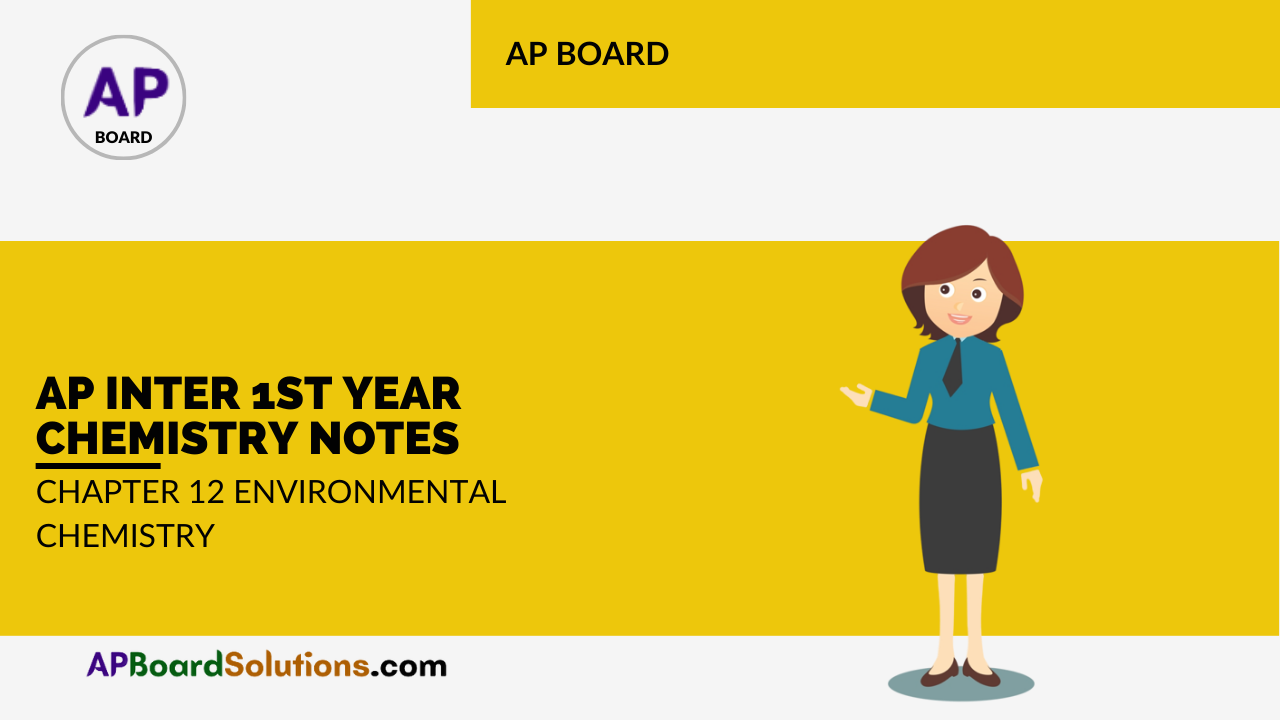Students can go through AP Inter 1st Year Chemistry Notes 12th Lesson Environmental Chemistry will help students in revising the entire concepts quickly.
AP Inter 1st Year Chemistry Notes 12th Lesson Environmental Chemistry
→ Our surroundings including air, water, soil, residence are collectively called Environment.
→ The protective blanket of gases surrounding the Earth is called atmosphere.
→ Environment can be divided into four segments.
- Atmosphere
- Hydrosphere
- Lithosphere
- Biosphere
→ A substance which grows in quantity due to human activity and adversely effects the environment is called as pollutant.
E.g. : SO2, CO, Pb, Hg etc.
→ A substance which is not present in nature, but released during human activity and has an adverse effect on environment is called as contaminant.
E.g. : Methyl Isocyanide (MIC).
→ The medium which is effected by the pollutant is called Receptor.
E.g. : Men, Plants, Animals, Constructions etc.
![]()
→ The medium which retains the pollutant in it and interacts with the long-lined pollutant in it is called sink sea water is a big sink of CO2.
→ The amount of oxygen present in water is called as Dissolved oxygen. For the healthy growth of plants and animals in water the DO required is 4 – 6 mg L-1.
→ The amount of oxygen required to oxidise organic substances present in water is called COD (Chemical Oxygen Demand). COD is an index of the organic chemical content of water.
→ The amount of oxygen used by the micro organisms present in water for five days is called as BOD (Biological Oxygen Demand) .
→ COD and BOD values determine the extent of pollution of water.
→ The permissible level of toxic pollutant in atmosphere to which a healthy industrial worker is exposed during an 8 – hour day without any adverse effect. This is called Threshold Limit Value (TLV).
→ Air pollution is caused by CO, CO2, H2S, Oxides of Sulphur (SOx), Oxides of Nitrogen (NOx), particulate matter (metals, dust, cement etc.)
→ Rain with pH of around 4 – 5 is called Acid – Rain. It is due to air pollution.
→ The phenomenon of heating up of the surface of the earth due to accumulation of CO2 and other gases such as CH4, CFC, O3, N2O, H2O is called Green house effect or Global Warming.
![]()
→ Permissible levels of Fluorine in water: < 2 ppm and > 1 ppm.
→ Ozone layer is present in the stratosphere and it protects life on Earth by filtering U.V. rays coming from Sun.
→ Ozone layer is depleted due to the action of chlorofluoro carbons (CFCs).
→ Deforestation causes Green house effect.
→ Ozone in the stratosphere acts as protective layer, but harmful if it is present in the troposphere.
→ Activated charcoal can adsorb certain organic substances like DDT and Endrin.
→ For defluoridation technique, activated charcoal is used. It adsorb Fluoride (F– ions).
→ The relationship between all living systems and their surroundings is Ecosystem.
→ Eutrophication : Lakes become over nutritions due to agricultural and industrial wastes. It leads to luxuriant growth of algae and ultimately become dry. This is called Eutrophication.
→ Soil pollution is mainly from
- Agricultural practices
- Industrial wastes
- Urban wastes
- Chemical and mechanical pollutants
- Mining
- Soil sediments
- Radioactive pollutants
- Biological agents etc.
→ To control soil pollution :
- collection of wastes
- disposal of wastes
- recovery of resources
- bio – remediation
- bio – technical approach
- vitrification
- Recycling and release of wastes.
→ Green chemistry involves not to produce green house gases like CH4, CO2 etc., are responsible for green house effect.
→ Green chemistry works for not producing wasteful by products in the processes.
